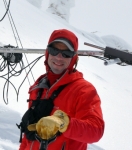I never thought I’d be concerned about my electronics while cruising around the backcountry, but I am. Carrying a cell phone, satellite phone, GPS, avalanche beacon, SPOT Messenger, and a VHF radio means my electronic signature rivals a high tension power line. I hope I don’t have to start lugging around a car battery to keep everything powered. Most people in the backcountry are not as wired as me, but a smartphone and beacon are staples for most backcountry travelers. The beacon is a literal lifeline, the most important piece of electronic safety equipment we carry.
Blog List


I never thought I’d be concerned about my electronics while cruising around the backcountry, but I am. Carrying a cell phone, satellite phone, GPS, avalanche beacon, SPOT Messenger, and a VHF radio means my electronic signature rivals a high tension power line. I hope I don’t have to start lugging around a car battery to keep everything powered. Most people in the backcountry are not as wired as me, but a smartphone and beacon are staples for most backcountry travelers. The beacon is a literal lifeline, the most important piece of electronic safety equipment we carry.

From the time snow crystals fall from the sky to time they melt in the spring, the shape and structure of each crystal never stops changing. This is known as snow metamorphism.
Snow metamorphism determines if individual snow crystals are rounding (becoming stronger) or faceting (becoming weaker). The relationship between snow crystals ultimately dictates what kind of layer, strong or weak, is formed. The interaction between individual layers determines snowpack stability.

From the time snow crystals fall from the sky to time they melt in the spring, the shape and structure of each crystal never stops changing. This is known as snow metamorphism.
Snow metamorphism determines if individual snow crystals are rounding (becoming stronger) or faceting (becoming weaker). The relationship between snow crystals ultimately dictates what kind of layer, strong or weak, is formed. The interaction between individual layers determines snowpack stability.

Cooke City has a deep slab problem: a 7+ foot thick snowpack resting on a layer of facets. This recipe might be a preview for the rest of our forecast area since there are still months of winter left. I tried to explain the problem with the analogy below. A proper, technical definition can be found on the Colorado Avalanche Information Center's website.
DEEP SLAB INSTABILITY: an analogy

I would love to know how many sets of tracks were wiped out in Sunday’s avalanche of the Football Field on Saddle Peak. If you carved a set consider yourself lucky. I’m going to guess that not many snowpits were dug and that the only form of stability assessment folks leaned on were that others had skied it beforehand. This was not smart. The avalanche broke during early morning avalanche control on the boundary of Bridger Bowl. An explosive was placed in-bounds, but the avalanche ripped out-of-bounds. Why?

Published in the January 2014 issue of CARVE.
The third week of December provided some valuable avalanche lessons when three people in two separate incidents triggered and were caught in avalanches near the Bridger Bowl boundary. In both cases the parties exited the ski area into the backcountry. The first incident involved two highly experienced skiers on Saddle Peak. Like they have done for years, they rode the Slaschman’s lift and hiked

Mountain snowmobiling is serious business in terms of avalanches. Modern sleds make it incredibly easy to ride deep powder in avalanche terrain. It is really fun but can also be really deadly. As always consider taking a class. Another great way to learn more is to watch a recently published series from the Canadian Avalanche Center (CAC) called "Throttle Decisions." It has 10 individual videos that were all very well done and worth watching.

Published in December issue of CARVE
I never thought I’d be concerned about my electronics while cruising around the backcountry, but I am. Carrying a cell phone, satellite phone, GPS, avalanche beacon, SPOT Messenger, and a VHF radio means my electronic signature rivals a high tension power line. I hope I don’t have to start lugging around a car battery to keep everything powered. Most people in the backcountry are not as wired as me, but a smartphone and beacon are staples for most backcountry travelers. The beacon is a literal lifeline, the most important piece of electronic safety equipment we carry. Its function is crucial to survival. As I slowly added to my electronic arsenal over the years I began to wonder, “Do all these other devices interfere with the function of my avalanche beacon?”

Snowmobilers die in avalanches every winter, killed by trauma or suffocation, an extremely unpleasant way to breathe your last breath. In the last 10 years 93 snowmobilers in western America have been killed in avalanches. This is no surprise. We love to ride steep, open, mountainous slopes in avalanche terrain. If you play in the lion’s den you may get eaten, but as riders we don’t have to go into the den when the lion is hungry.

Published in December issue of SnoWest Magazine
Snowmobilers die in avalanches every winter, killed by trauma or suffocation, an extremely unpleasant way to breathe your last breath. In the last 10 years 93 snowmobilers in western America have been killed in avalanches. This is no surprise. We love to ride steep, open, mountainous slopes in avalanche terrain. If you play in the lion’s den you may get eaten, but as riders we don’t have to go into the den when the lion is hungry.

Published in CBU November Newsletter
The day dawns cold and clear with a foot of fresh snow and the promise of incredible powder riding. At the trailhead, the surrounding landscape sparkles like a field of diamonds and the anticipation of a magical day in the mountains builds.
Sled covers are hastily removed and the machines are fired up - the smell of exhaust fills the air. Feeling confident about preparations, members of the group do a quick gear check and then hop on their machines, pinning their throttles towards the backcountry and a day of powder riding.

YES. Portable electronics like phones, radios, GPS, cameras, etc. will interfere with an avalanche beacon (aka avalanche transceiver). Is it a problem? The interference is significant and may prevent you from finding a buried partner. These electronic devices typically need to be turned on to cause interference. Snowmobiles with running motors and electrical circuits will also cause interference.

Blue ice clings to canyon walls, creating a colorful contrast to the steep rock faces of Hyalite Canyon. Climbers inch their way up the frozen surface with axes and crampons, many having traveled from around the world to experience this world class venue.

Staying on top during the Bozeman Ice Festival
By: Eric Knoff
Avalanche Forecaster - Gallatin National Forest Avalanche Center
Blue ice clings to canyon walls, creating a colorful contrast to the steep rock faces of Hyalite Canyon. Climbers inch their way up the frozen surface with axes and crampons, many having traveled from around the world to experience this world class venue.

I just got back from a dawn patrol ski tour in the Bridgers! Yesterday’s snowstorm dumped heaps of snow at the higher elevations and the skiing was the better than I ever would have guessed.
Ok, I’m joking. But admit it, you got a little excited, didn’t you?

We just wrapped up our 23rd season at the Gallatin National Forest Avalanche Center, one of the best winters ever: lots of snow, many days of good stability, and no fatalities. It has been nine years we’ve had this combination.

Riding in the sidecountry is fun, and it is marketable. Google ‘sidecountry’ and you get 438,000 search results. As more people recreate in the sidecountry, ski areas promote it, equipment manufacturers capitalize on it, riders benefit through new technology and increased availability, the media eats it up, more people want the experience, and WHAM!

Since 1997 forty one snowmobilers have died in avalanches in Montana, the most of any state in the nation. Twenty of these fatalities occurred in the Gallatin National Forest of southwest Montana, and thirteen occurred during HIGH avalanche danger.

For many resort skiers, the word “sidecountry” has become a standard definition of backcountry terrain adjacent to a ski area. Usually the acreage on the other side of the boundary is administered by the US Forest Service and the ski area becomes a convenient jumping off point to access public lands. In the last few years skiers have overwhelmingly embraced this access as the in-bound crowds ski up new snow at a ferocious pace. Untracked powder is a dwindling resource, an addictive drug, and access gates are the needle in a vein to a quick fix.
